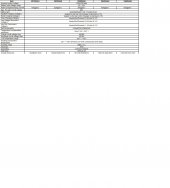Greetings
I recently made a controller and battery upgrade from PWM and Gel to MPPT and Lithium, but I’m a bit disappointed by the poor performance of the MPPT controller and I need help please, it hardly reach the Float Voltage when in use and never the Boost voltage neither. I use a day permanent load of 30 Amps 12 Volts in sunny days and with the old configuration the battery reached the Boost and Float voltage from the morning until evening but now almost never.
This was my old and new configuration.
3 x 300 Watts. 12 Volt 16.5 Amp Solar panels. Connected in parallel.
Epever 60 Amp PWM ControllerVS6024AU
250 Amp. 12 Volt. Gel battery.
New Configuration.
3 x 300 Watts. 12 Volt, 16.5 Amp Solar panels. Connected in series.
Epever 60 Amp Tracer 6415AN
300 AH LIFEO4 Lithium battery
The MPPT controller reaches easily a 50 Amp but voltage hardly 13.5 when in load and the result is not a 100% charged battery at the end of the day.
The controller configuration was set in the place where I purchased it. It was done for a 300Amp lithium battery (Wifi using the android application). I remember as I was watching quickly the parameters that float was 13.8 Volt and Boost 14.4 Volt (not sure maybe 14.6) and reconnect 13.2 Volt.
Can anyone please let me know if it is normal not to reach float and boost voltage with a clear day with a load of 30 Amps like my old setup or a malfunction?
If I do not use the system the battery reach 100% and the voltage reaches float.
Thanks very much ahead
I recently made a controller and battery upgrade from PWM and Gel to MPPT and Lithium, but I’m a bit disappointed by the poor performance of the MPPT controller and I need help please, it hardly reach the Float Voltage when in use and never the Boost voltage neither. I use a day permanent load of 30 Amps 12 Volts in sunny days and with the old configuration the battery reached the Boost and Float voltage from the morning until evening but now almost never.
This was my old and new configuration.
3 x 300 Watts. 12 Volt 16.5 Amp Solar panels. Connected in parallel.
Epever 60 Amp PWM ControllerVS6024AU
250 Amp. 12 Volt. Gel battery.
New Configuration.
3 x 300 Watts. 12 Volt, 16.5 Amp Solar panels. Connected in series.
Epever 60 Amp Tracer 6415AN
300 AH LIFEO4 Lithium battery
The MPPT controller reaches easily a 50 Amp but voltage hardly 13.5 when in load and the result is not a 100% charged battery at the end of the day.
The controller configuration was set in the place where I purchased it. It was done for a 300Amp lithium battery (Wifi using the android application). I remember as I was watching quickly the parameters that float was 13.8 Volt and Boost 14.4 Volt (not sure maybe 14.6) and reconnect 13.2 Volt.
Can anyone please let me know if it is normal not to reach float and boost voltage with a clear day with a load of 30 Amps like my old setup or a malfunction?
If I do not use the system the battery reach 100% and the voltage reaches float.
Thanks very much ahead



